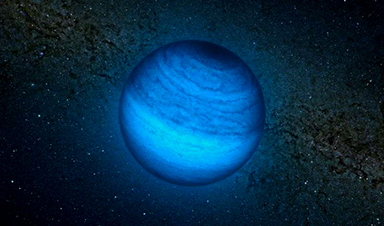An international team of astronomers led by Philippe Delorme of the Grenoble Alpes University in France has recently investigated a mysterious object designated CFBDSIR J214947.2-040308.9 (CFBDSIR 2149-0403 for short) in order to reveal its true nature. The object is assumed to be a young isolated planetary-mass object or a high-metallicity low-mass brown dwarf. The results of new observations published Mar. 2 in a paper on arXiv.org could help distinguish between these two classes.
CFBDSIR 2149-0403 was detected in 2012 by Delorme and his team as a possible member of the AB Doradus moving group. After its discovery, it was classified by the researchers as a unique T-type isolated planetary-mass candidate. However, due to the lack of convincing evidence supporting the hypothesis that CFBDSIR 2149-0403 formed as a planet and was subsequently ejected, the scientific community does not exclude the possibility that it could be a low-mass brown dwarf.
In order to to fully characterize CFBDSIR 2149-0403 and to constrain its nature, the team has conducted multi-instrument, multi-wavelength follow-up observations of this object. The list of instruments used by Delorme and his colleagues includes the Very Large Telescope’s (VLT) X-Shooter spectrograph and HAWK-I near-infrared imager, WIRCam imager at the Canada–France–Hawaii Telescope and NASA’s Spitzer Space Telescope.
“The X-Shooter data enabled a detailed study of the physical properties of this object. However, all the data presented in the paper is really necessary for the study, especially the follow-up to obtain the parallax of the object, as well as the Spitzer photometry. Together, they enable us to get the bolometric flux of the object, and hence constraints that are almost independent from atmosphere model assumptions,” Delorme told Phys.org.
Besides determining the object’s parallax, the follow-up observations also allowed the researchers to derive its six-dimensional position and kinematics. These results indicate that CFBDSIR 2149-0403 is most likely not a member of the AB Doradus moving group, as was claimed in earlier studies, thereby removing any strong independent constraint on its age.
[button link=”https://phys.org/news/2017-03-optical-nanosensor-brain-accuracy-applications.html” color=”custom” size=”medium” stretch=”” type=”flat” shape=”pill” target=”_blank” title=”” gradient_colors=”|” gradient_hover_colors=”|” accent_color=”” accent_hover_color=”” bevel_color=”” border_width=”1px” icon=”” icon_divider=”yes” icon_position=”left” modal=”” animation_type=”0″ animation_direction=”down” animation_speed=”0.1″ animation_offset=”” alignment=”left” class=”” id=””]Read more at phys.com[/button]![]()
Image Credit: Doi:10.1117/1 (sic)
[title size=”2″ content_align=”left” style_type=”single solid” sep_color=”” margin_top=”” margin_bottom=”” class=”” id=””]Recent News[/title][recent_posts layout=”default” hover_type=”zoomin” columns=”3″ number_posts=”120″ offset=”” cat_slug=”News” exclude_cats=”” thumbnail=”yes” title=”yes” meta=”yes” excerpt=”yes” excerpt_length=”30″ strip_html=”yes” animation_type=”0″ animation_direction=”down” animation_speed=”1″ animation_offset=”” class=”” id=””][/recent_posts]






Leave A Comment